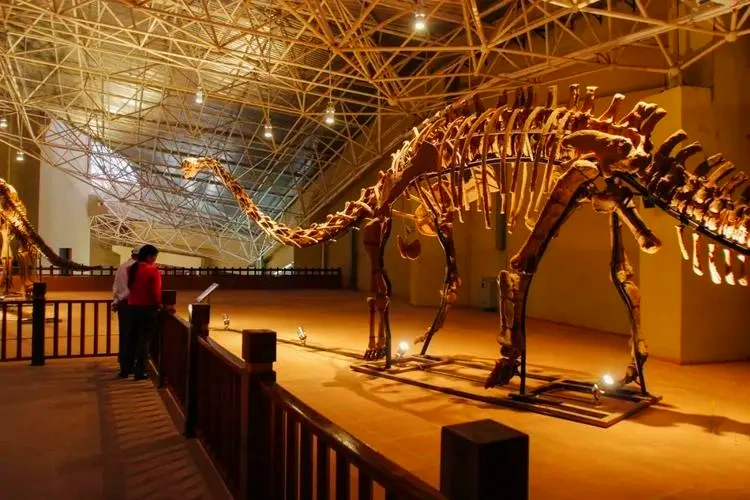 alt="Dali Erhai Lake Ecological Corridor from Xiaguan to Taoyuan"
/>
alt="Dali Erhai Lake Ecological Corridor from Xiaguan to Taoyuan"
/>
Yuanmousaurus in Yunnan
Yuanmousaurus was a sauropod dinosaur from the Middle Jurassic period of China. Known from incomplete remains, it was discovered in 2000 from the Zhanghe Formation in Yuanmou County, Yunnan Province. The type species, Yuanmousaurus jiangyiensis, was described in 2006 by Lü Junchang and colleagues. This dinosaur was a relatively large sauropod, potentially reaching about 17 meters (56 feet) in length. It is classified as a basal member of the Sauropoda, although its exact systematic position remains unclear. Recent studies have placed Yuanmousaurus within the family Mamenchisauridae.
Description
Yuanmousaurus was estimated to be approximately 17 meters (56 feet) long. The fossil record for this dinosaur is incomplete, with the skull missing and the neck represented only by a fragment of a posterior cervical vertebra. This fragment suggests that the neck vertebrae were elongated, similar to those of mamenchisaurid sauropods, but unlike the shorter neck vertebrae of the more basal Shunosaurus.
From the trunk and tail, nine dorsal, three sacral, and seven caudal vertebrae were found. While the shoulder and pelvic girdles are mostly missing, except for one ilium, the limbs are better represented. The fossils include the humerus, ulna, radius, thigh bone, tibia, fibula, astragalus, and a claw from the hind foot. The forelimbs of Yuanmousaurus were proportionally longer than those of the short-necked Shunosaurus but shorter than those of Omeisaurus. Specifically, the length ratio between the humerus and thigh bone was 0.72 in Yuanmousaurus, compared to 0.56 in Shunosaurus and 0.80 in Omeisaurus.
Classification
Yuanmousaurus is considered a basal member of the Eusauropoda, which is outside the Neosauropoda that comprises all more derived sauropods. In its species description, Lü Junchang and colleagues initially classified Yuanmousaurus as a member of the Euhelopodidae, suggesting it was closely related to Patagosaurus, more basal than Euhelopus, and more derived than Omeisaurus. However, the Euhelopodidae has been largely abandoned by many paleontologists due to the controversial systematic position of Euhelopus itself. A newer analysis by Toru Sekiya places Yuanmousaurus within the Mamenchisauridae, along with Mamenchisaurus, Tienshanosaurus, and Chuanjiesaurus.
Discovery
The only known skeleton of Yuanmousaurus (specimen YMV 601) was recovered in May 2000 in the village of Jiangyi in Yuanmou County, Yunnan Province. The excavation was led by paleontologists from the Yunnan Provincial Institute of Cultural Relics and Archaeology, the Yuanmou Museum, and the Chuxiong Museum. Today, the fossils are part of the Yuanmou Museum collection. The name Yuanmousaurus jiangyiensis refers to Yuanmou County and the village of Jiangyi, where the fossils were found.

 7 Days GolfingTour
7 Days GolfingTour
 8 Days Group Tour
8 Days Group Tour
 8 Days Yunnan Tour
8 Days Yunnan Tour
 7 Days Shangri La Hiking
7 Days Shangri La Hiking
 11 Days Yunnan Tour
11 Days Yunnan Tour
 6 Days Yuanyang Terraces
6 Days Yuanyang Terraces
 11 Days Yunnan Tour
11 Days Yunnan Tour
 8 Days South Yunnan
8 Days South Yunnan
 7 Days Tea Tour
7 Days Tea Tour
 8 Days Muslim Tour
8 Days Muslim Tour
 12 Days Self-Driving
12 Days Self-Driving
 4 Days Haba Climbing
4 Days Haba Climbing
 Tiger Leaping Gorge
Tiger Leaping Gorge
 Stone Forest
Stone Forest
 Yunnan-Tibet
Yunnan-Tibet
 Hani Rice Terraces
Hani Rice Terraces
 Kunming
Kunming
 Lijiang
Lijiang
 Shangri-la
Shangri-la
 Dali
Dali
 XishuangBanna
XishuangBanna
 Honghe
Honghe
 Kunming
Kunming
 Lijiang
Lijiang
 Shangri-la
Shangri-la
 Yuanyang Rice Terraces
Yuanyang Rice Terraces
 Nujiang
Nujiang
 XishuangBanna
XishuangBanna
 Spring City Golf
Spring City Golf
 Snow Mountain Golf
Snow Mountain Golf
 Stone Mountain Golf
Stone Mountain Golf













 What Our Customers Say?
What Our Customers Say?
